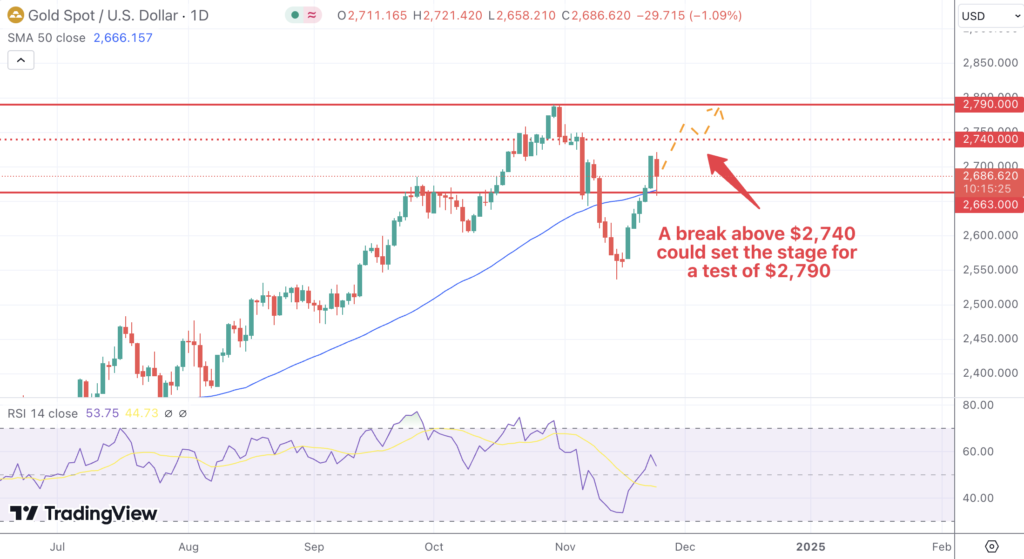Key Takeaways:
- Gold’s bullish trend remains intact, with $2,663 as key support and $2,790 as the next resistance target.
- Safe-haven demand driven by geopolitical risks continues to be a major driver of gold’s upward momentum.
- The market’s focus will be on U.S. inflation data and Federal Reserve commentary to gauge the likelihood of a December rate cut.
Market Dynamics and Recent Performance
Gold (XAU/USD) closed last week at $2,716, marking a strong rebound with a 5.97% gain fueled by safe-haven demand and changing Federal Reserve rate expectations. Geopolitical tensions, particularly the escalating Russia-Ukraine conflict, have contributed significantly to gold’s rally, adding over $170 to its value since its November low of $2,536. Market speculation about a potential December Fed rate cut further bolstered gold, despite a relatively firm U.S. dollar.
The precious metal’s movement underscores its dual role as a hedge against uncertainty and a non-yielding asset that thrives in dovish monetary environments. The mixed U.S. economic data—highlighting strength in employment but weakness in manufacturing—also influenced sentiment, supporting gold’s rally while capping the dollar’s gains.
Technical and Fundamental Influences
Technically, gold remains in a bullish posture after closing above the key pivot level of $2,663. This level now acts as strong support, with analysts identifying $2,790 as the next major resistance target. The metal’s RSI on the daily chart is nearing overbought territory, indicating potential consolidation. However, gold’s weekly momentum remains robust, as it continues to trade above its 50-day and 200-day moving averages, signaling that the broader uptrend remains intact.

Gold’s rebound has been amplified by a convergence of safe-haven flows and shifting rate expectations. The market currently assigns a 53% probability to a Fed rate cut in December, keeping the metal attractive as an alternative to yield-bearing assets. Yet, with bond yields and the U.S. dollar still elevated, any upward momentum may face intermittent resistance.
On the geopolitical front, the intensifying Russia-Ukraine conflict has been a significant driver, as fears of further escalation keep investors on edge. Such geopolitical developments, combined with inflationary pressures and uncertain global growth prospects, create a fertile environment for gold’s sustained strength.
Looking Forward
The week ahead will likely see gold consolidating its recent gains as traders focus on upcoming U.S. inflation data and Federal Reserve commentary. A break above $2,740 could set the stage for a test of $2,790, while any failure to hold above $2,663 may lead to a pullback toward $2,640. The market will also be closely watching geopolitical developments and their potential to sustain safe-haven flows into gold.
Expectations for a dovish shift from the Fed, coupled with the potential for weaker economic data, could further support gold’s advance. Conversely, stronger-than-expected U.S. data or de-escalation in global tensions may temper its rally.

